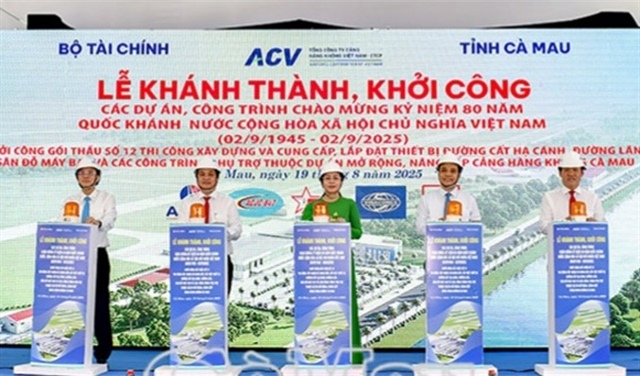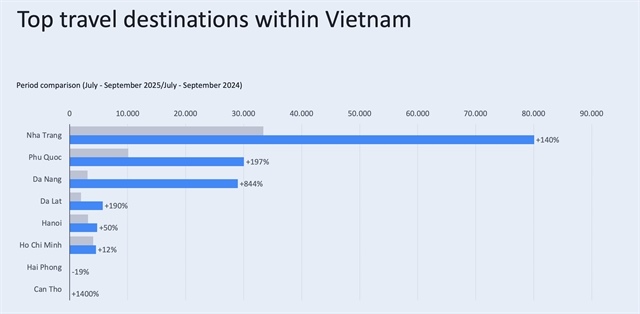Inflation falls from 23% to 5% in one year
Inflation falls from 23% to 5% in one year
Policymakers have signalled that they are willing to take necessary actions to move the economy forward,the Hong Kong and Shanghai Bank (HSBC) has said in its monthly research report.

"Vietnam at a Glance" notes that inflation declined to 5 per cent in July from 23 per cent in August 2011. The trade deficit, too, narrowed to US$58m in the first seven months compared to almost $6bn a year earlier.
The dong has been stable for most of the year while forex reserves have risen, bolstered by both an improved trade deficit and strong FDI disbursements.
The government recently passed resolutions aimed at increasing the efficiency of State-owned enterprises and the banking sector.
But the slowing of credit growth (less than 1 per cent in the year-to-date) reflects both weak internal demand, a symptom of structural weaknesses, as well as external factors.
Since the mid-2000s the economy has become highly leveraged – referring to borrowing to invest — and much of the investment went into unproductive activities.
The tightening of credit reveals Viet Nam's dependence on credit to sustain growth, an unsustainable strategy as it increases systemic risk and fuels inflationary pressures.
At the same time it also reflects the government's commitment to shed the system of bad debt. The credit-to-GDP ratio declined from 121 per cent in 2010 to 108 per cent in 2011 though still high compared to just 48 per cent in 2003.
This deleveraging process will continue in the coming years.
Businesses in Viet Nam are suffering from both low domestic demand and weak global growth. HSBC's Vietnam Manufacturing Purchasing Managers' Index (PMI) contracted in July to its lowest level since it began to be tracked in April 2011.
This mirrors consumers' unwillingness to spend due to either high debt or a challenging outlook for growth. Cautious spending behaviours, both from corporations and consumers, and slowing inflation suggest that the SBV will step up its easing.
Following the tightening cycle last year, the SBV has already eased most policy rates by 5 per cent since the beginning of 2012 to spur weak domestic demand.
However, this has not impacted spending yet, given that consumers and firms are either saddled with debt or cautious.
The July PMI shows both new orders and new export orders declining to the lowest levels since the series began, showing also weakened demand for goods in Europe and China. But the biggest issue cited by managers was consumers' unwillingness to spend.
On the flip side, the lack of demand, coupled with low commodity prices, has caused input prices to drop, alleviating some of the cost burden for firms.
Output prices have also declined due to this as well as increased competition, reflecting an easing in overall inflationary pressure.
Just like their customers, manufacturing firms are also cutting back, adopting a more cautious stance on spending.
There has been a cutback in employment as well as quantity of purchases, possibly indicating that firms are not expecting a recovery in demand anytime soon.
Purchases were down sharply, as were inventories, showing managers' bleak future outlook.
The weaker trade numbers reflect both low internal and external demand. On a year-on-year basis, exports rose by 3.8 per cent in July against 14.3 per cent in June.
Seasonally adjusted, July marks a second month of contraction on a month-on-month basis. Exports are showing a deepening trend of contraction due to weaker shipments of aquatic produce, rubber, computer and electronics, coal, and tea, reflecting weakening demand mostly in China and Europe.
Imports weakened to a 9 y-o-y growth from 13.6 per cent, falling 3.7 per cent m-o-m from a 0.5 per cent decline in June.
With the eurozone in a recession and the US slowing, demand for Vietnameseexports will likely decelerate further, meaning export growth is likely to be only 13.7 and not 16.6 per cent as forecast earlier. Import growth is likely to be down to 6.5 from 12.3 per cent.
The full-year trade deficit is likely to narrow to $3.5bn (revised downward from $6.4bn).
More easing on the way
Even if easing measures spur spending towards the year-end, demand will only pick up gradually. There is more easing on the way, but it is unlikely to significantly impact demand.
Inflation slowed to 5.3 y-o-y from 6.9 per cent in June. On a seasonally adjusted basis, prices picked up slightly to 0.1 per cent m-o-m from a contraction of 0.1 per cent in June. Most of the slowdown came from food, which rose by only 3.6 per cent y-o-y compared to 6.3 per cent the month before.
Inflation will continue to decelerate further in the coming months, helped by a very favourable base effect as well as low demand.
This gives scope for the State Bank of Vietnam to ease policy rates further, with another 1 per cent cut in the discount, refinance, and deposit rates expected soon.
Another 1 per cent rate cut in the open market operations rate is increasingly likely after it was reduced by 6 per cent to 8 per cent at the end of 2011 as growth remains weak and core inflation will bottom at around 7 per cent.
But the cuts are unlikely to impact credit conditions significantly. The SBV has already announced that it will step up efforts to pump credit into the economy during the rest of the year.
Given individuals and firms are going through a deleveraging process, they are either unwilling to take out new loans or unable to because of the lack of collateral and higher indebtedness.
This means that even banks that are flush with cash may not be able to expand their balance sheets aggressively.
The SBV governor announced that the deposit rate cap will be lowered to below 8 per cent from 9 per cent now to force banks to lower lending rates that are currently around 15 per cent.
But a stimulus similar to the one implemented in 2009 is unlikely since high inflation last year makes easy credit less of an appealing solution, especially when much of this goes to inefficient sectors.
Besides, fiscally stimulating the economy through government spending is also not attractive given that policymakers recently announced a new strategy to reduce the budget deficit as well increase the efficiency of public investment.
Still, while it might be painful to swallow sub-trend growth rates for a while, Viet Nam is on the right track, cutting debt and adopting productivity boosting measures, which, ultimately, will launch the economy back on a path of rapid growth.
vietnamnet





















